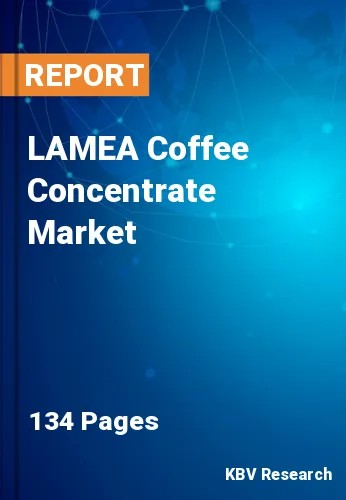The Latin America, Middle East and Africa Coffee Concentrate Market would witness market growth of 7.7% CAGR during the forecast period (2023-2030). In the year 2026, the LAMEA market's volume is expected to surge to 7,309.5 thousand litres, showcasing a growth of 9.1% (2023-2030).
Consumer demand for transparency in sourcing and production practices is prompting coffee concentrate brands to emphasize traceability. Brands that communicate the journey of their coffee beans, from origin to processing, build trust with consumers who value ethical and sustainable practices. Furthermore, the intersection of coffee and mixology gives rise to low or no-alcohol coffee cocktails. This is a versatile ingredient for creating sophisticated and flavourful non-alcoholic beverages that mimic the complexity of traditional cocktails.
The exploration of diverse and exotic flavour profiles is anticipated to continue. These producers may experiment with unique blends, botanical infusions, and innovative flavours to capture consumers' attention-seeking novel and sophisticated taste experiences. The integration of health and wellness attributes into coffee concentrates is expected to grow. Producers may incorporate functional ingredients, such as adaptogens, vitamins, and natural health-enhancing additives, to align with consumer trends toward beverages that offer flavour and potential health benefits.
Brazil is the preeminent coffee producer in Latin America and a significant contributor to the continent's overall output. The nation is renowned for its substantial output of Arabica and Robusta legumes. According to the Government of Brazil, for the 2022 harvest, Brazil produced 55.7 million sacks of coffee, represents an increase of 16.8% compared to production in 2021. Furthermore, the Arabica variety yield an additional 38.7 million sacks in 2022, representing a 23.4% increase over the previous harvest. Moreover, data from the Dubai Municipality revealed the food service establishments in the Dubai Emirate. With 18,667 food establishments, 9,705 are restaurants, 4,310 are coffee shops, 2,809 are cafeterias, 840 are hotels, and 728 are catering services. Hence, the high production of coffee and increasing food service establishments in the region are propelling the market's growth.
The Brazil market dominated the LAMEA Coffee Concentrate Market, By Country in 2022, and would continue to be a dominant market till 2030; thereby, achieving a market value of $84.2 Million by 2030. The Argentina market is showcasing a CAGR of 8.3% during (2023 - 2030). Additionally, The UAE market would register a CAGR of 7.4% during (2023 - 2030).
Free Valuable Insights: The Worldwide Coffee Concentrate Market is Projected to reach USD 3.6 Billion by 2030, at a CAGR of 5.3%
Based on Type, the market is segmented into Caffeinated, and Decaffeinated. Based on Distribution Channel, the market is segmented into Retail, and HoReCa. Based on Retail Type, the market is segmented into Supermarkets/Hypermarkets, Specialty Stores, Convenience Stores, and Online Retail. Based on countries, the market is segmented into Brazil, Argentina, UAE, Saudi Arabia, South Africa, Nigeria, and Rest of LAMEA.
By Type (Volume, Thousand Litres, USD Billion, 2019-2030)
By Distribution Channel (Volume, Thousand Litres, USD Billion, 2019-2030)
By Country (Volume, Thousand Litres, USD Billion, 2019-2030)
Our team of dedicated experts can provide you with attractive expansion opportunities for your business.

